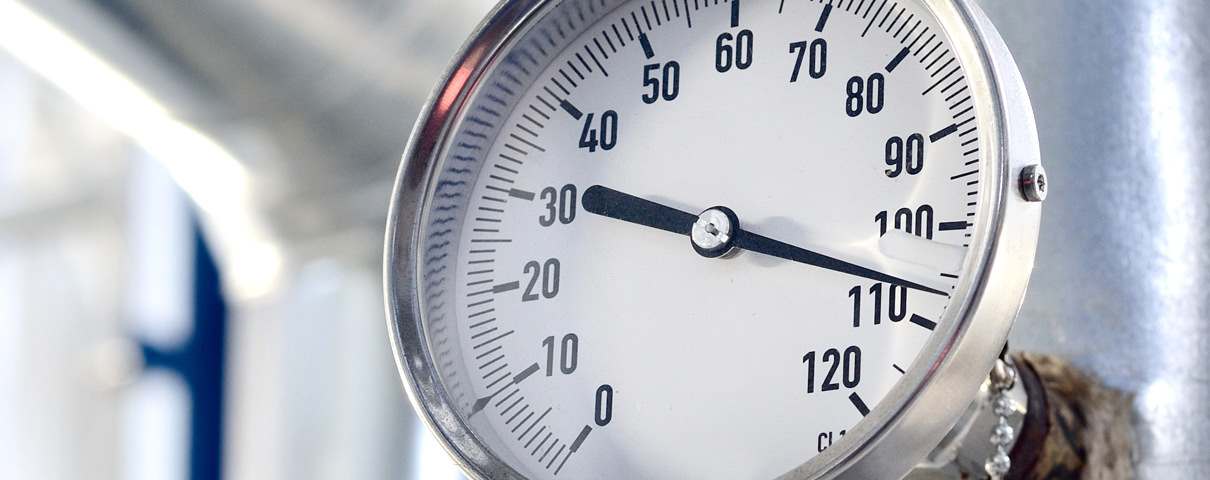
Answers to questions about the basics of pressure measurement, including why measuring gauge pressure is fine for most applications but absolute pressure measurement is required in some cases.
What is pressure?
Generally speaking, pressure is defined as a force that acts uniformly over a specified area. When you press the button on a doorbell, for example, the pressure of your fingertip applies a physical force that triggers an electric actuation switch inside the doorbell, which then sends a signal to chime. In industrial applications, the force that is applied over an area is usually a gas or liquid, but it can also be a solid.
Why do we measure pressure?
Pressure measuring and monitoring is an essential part of modern industrial processes. Across the globe, countless pressure sensors, gauges, and transmitters provide pressure readings in refineries, manufacturing facilities, laboratories, airplanes, homes, and cars. This is done to ensure that the pressure is within acceptable bounds and, if not, to alert operators or users to rectify the situation.
What is absolute pressure, and how does that compare to gauge pressure?
To understand absolute pressure, one must first define a few terms:
- Atmospheric pressure. Everything around us – the air and water – has weight and creates pressure. At sea level, the average pressure is 1 atm, or around 14.7 psi (pounds per square inch). As elevation increases, the air gets thinner, and so does the atmospheric pressure. Atmospheric pressure also varies according to weather conditions.
- Gauge pressure. The zero reference in gauge pressure is the atmospheric pressure, which means a gauge pressure reading shows just the additional pressure within a system. For this reason, gauge pressure is also called overpressure, as this is the pressure over atmospheric pressure.
- Absolute pressure. The zero reference in absolute pressure is a perfect vacuum, which has no atmospheric pressure at all. Therefore, an absolute pressure reading displays the sum of the atmospheric pressure and the gauge pressure.
An important distinction between the latter two types of pressure is the zero reference and whether that reference point moves. The zero in instruments that measure gauge pressure is ambient air, which varies according to elevation and weather conditions. The zero in instruments that measure absolute pressure is the total absence of pressure, or a vacuum; therefore, this zero does not vary.

Model 532.X absolute pressure gauge with diaphragm element
How does an absolute pressure gauge work?
Absolute pressure gauges have an internal vacuum chamber that is used as a reference for making pressure measurements. Diaphragm-based absolute pressure gauges have a firm yet flexible panel that separates a media chamber and a vacuum chamber. The local ambient pressure in the media chamber causes the diaphragm to deform into the vacuum chamber. The amount of deformation is converted into a pressure value. This value is then indicated on the gauge dial.
What are the advantages of measuring absolute pressure vs. gauge pressure?
Since all the facilities in a refinery or manufacturing plant share the same elevation and atmospheric pressure, measuring gauge pressure is accurate enough for most processes. However, specialized situations call for absolute pressure, which are independent of fluctuations in atmospheric pressure. Absolute pressure gauges and transmitters are found in numerous applications, including altimeters for aviation, monitors for liquid vapor pressure, distillation processes, HVAC, and semiconductor manufacturing. The pressure of dangerous arsine and phosphine gases used in the semiconductor manufacturing process must be carefully monitored during storage and transport. Because atmospheric conditions fluctuate, it’s important when monitoring dangerous gases to use a reference point that does not change.
WIKA USA carries a comprehensive portfolio of pressure gauges for measuring gauge pressure, absolute pressure, and differential pressure. For more information about which instrument is right for your processes and applications, contact our pressure specialists.

